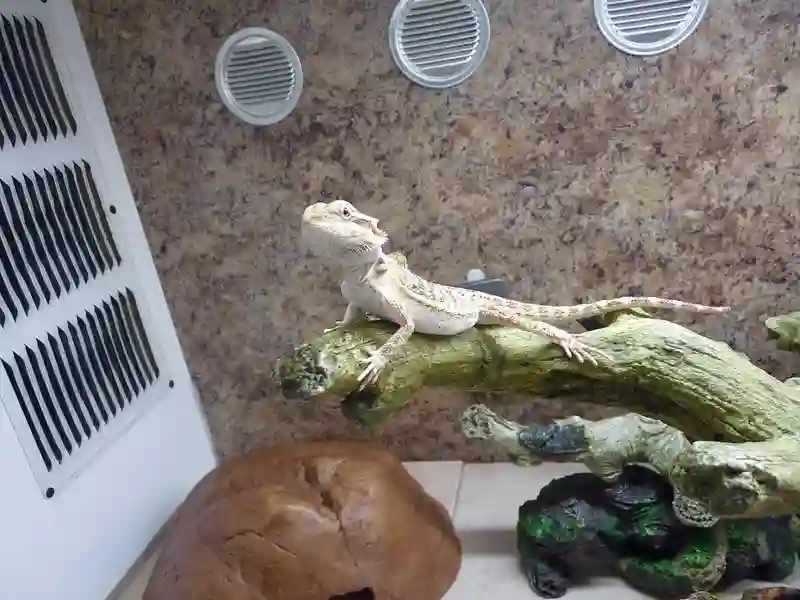Porcelain tile can be used in a bearded dragon cage. It may not be the best choice for flooring option since it can be hard and cold.
It is also not as safe as reptile tile substrate since bearded dragons tend to scoop up some of the ground when capturing prey, and substrates made of sand, wood, or pebbles can get ingested.
Here are some pros and cons of using porcelain tile as a substrate for a bearded dragon cage:
Pros:
- Non-porous and easy to clean
- Comes in a variety of colors and textures
Cons:
- Hard and cold
- Not as safe as a reptile tile substrate
If you decide to use porcelain tile as a substrate, you can cut a piece of plywood to fit the enclosure and tile it like you tile any floor but on a much smaller scale.
Once you have your bearded dragon tile floor installed, place the enclosure somewhere in your home that is quiet, dark at night, and out of direct sunlight.
Advantages of using porcelain tile in a bearded dragon cage
Porcelain tile is an incredibly durable material that can withstand heavy foot traffic, spills, and scratches. This makes it perfect for use in a bearded dragon cage where the animal may scratch or dig its claws into the floor surface.
Easy to clean and sanitize
Bearded dragons have sensitive respiratory systems that require clean and hygienic living conditions. Porcelain tile is easy to clean and sanitize, making it an ideal choice for pet owners who want to maintain a healthy environment for their reptiles.
Non-porous surface that does not harbor bacteria or other harmful organisms
Porcelain tiles have non-porous surfaces that do not allow bacteria or other harmful organisms to penetrate the material. This makes it an excellent option for use in bearded dragon cages where cleanliness is essential. The non-porous surface also prevents liquids from seeping into the material, which can cause unpleasant odors.
Heat-resistant properties that can withstand the heat lamps necessary for a bearded dragon’s health
Bearded dragons require heat lamps to maintain their body temperature as they are cold-blooded animals. These heat lamps produce high temperatures which can damage some types of flooring materials such as vinyl or carpeting.
However, porcelain tiles are highly resistant to heat damage and will not warp or discolor under high temperatures.
Alternative Options for Flooring in a Bearded Dragon Cage
While porcelain tile may be a great option for a bearded dragon cage, other types of tile can also be used. Ceramic tiles are often less expensive than porcelain and come in a wide variety of colors and patterns. However, they may not be as durable or heat-resistant as porcelain tiles.
Natural stone tiles, like slate or granite, can also provide a unique and natural look to the cage but can be more expensive and require sealant to prevent stains. It is important to consider the texture and thickness of any tile used in the cage.
Smooth surfaces can help prevent injuries to your pet’s feet, while textured surfaces may provide traction when climbing. The thickness of the tiles should also be considered to ensure they can withstand the weight of your pet.
Reptile Carpet or Paper Substrates
Another flooring option for a bearded dragon cage is reptile carpet or paper substrates. These materials are often softer than tile and provide cushioning for your pet’s feet.
They come in various colors and designs, allowing you to customize the look of your cage. Reptile carpet is machine-washable, making it easy to clean, while paper substrates need to be replaced more frequently but may save time on cleaning between replacements.
However, it is important to note that both reptile carpets and paper substrates require regular cleaning and maintenance to prevent bacteria buildup that could harm your pet’s health. They may also not provide enough heat resistance if you use heat lamps within the cage.
Ultimately, choosing an appropriate flooring option for your bearded dragon’s cage depends on various factors such as durability, maintenance requirements, cost-effectiveness, and aesthetics among others. It might take some trial and error until you find what works best for you and your pet, but providing a safe and healthy habitat is worth the effort.
Conclusion
Porcelain tile is a great flooring option for bearded dragon cages, providing durability, easy maintenance, and the ability to withstand the high heat requirements of these reptiles.
The advantages of using porcelain tile in bearded dragon cages outweigh any potential drawbacks when proper installation and maintenance are implemented. It is important to consider the size, shape, and texture of the tiles when selecting porcelain tile flooring for a bearded dragon cage.
Proper installation and appropriate grout selection are crucial to ensure safety and prevent any shifting or cracking. Overall, choosing a safe and healthy environment for your pet reptile is essential in maintaining their overall health and well-being.
When selecting materials for your bearded dragon’s habitat, always make sure they meet requirements such as heat resistance and non-porosity to better maintain hygiene standards.
With porcelain tile flooring used properly in their cage setup alongside other suitable living adjustments, you can create an ideal habitat that promotes long-term health benefits while creating a safe space that will keep your pet feeling comfortable throughout its life cycle.

Leave a Reply